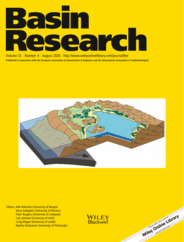
Full text loading...
Models to explain alluvial system development in rift settings commonly depict fans that are sourced directly from catchments formed in newly uplifted footwalls, which leads to the development of steep‐sided talus‐cone fans in the actively subsiding basin depocentre. The impact of basin evolution on antecedent drainage networks orientated close to perpendicular to a rift axis, and flowing over the developing hangingwall dip slope, remains relatively poorly understood. The aim of this study is to better understand the responses to rift margin uplift and subsequent intrabasinal fault development in determining sedimentation patterns in alluvial deposits of a major antecedent drainage system. Field‐acquired data from a coarse‐grained alluvial syn‐rift succession in the western Gulf of Corinth, Greece (sedimentological logging and mapping) has allowed analysis of the spatial distribution of facies associations, stratigraphic architectural elements and patterns of palaeoflow. During the earliest rifting phase, newly uplifted footwalls redirected a previously established fluvial system with predominantly southward drainage. Footwall uplift on the southern basin margin at an initially relatively slow rate led to the development of an overfilled basin, within which an alluvial fan prograded to the south‐west, south and south‐east over a hangingwall dip slope. Deposition of the alluvial system sourced from the north coincided with the establishment of small‐scale alluvial fans sourced from the newly uplifted footwall in the south. Deposits of non‐cohesive debris flows close to the proposed hangingwall fan apex pass gradationally downstream into predominantly bedload conglomerate deposits indicative of sedimentation via hyperconcentrated flows laden with sand‐ and silt‐grade sediment. Subsequent normal faulting in the hangingwall resulted in the establishment of further barriers to stream drainage, blocking flow routes to the south. This culminated in the termination of sediment supply to the basin depocentre from the north, and the onset of underfilled basin conditions as signified by an associated lacustrine transgression. The evolution of the fluvial system described in this study records transitions between three possible end‐member types of interaction between active rifting and antecedent drainage systems: (a) erosion through an uplifted footwall, (b) drainage diversion away from an uplifted footwall and (c) deposition over the hangingwall dip slope. The orientation of antecedent drainage pathways at a high angle to the trend of a developing rift axis, replete with intrabasinal faulting, exerts a primary control on the timing and location of development of overfilled and underfilled basin states in evolving depocentres.
,A high‐resolution sedimentological dataset has been analysed from an early syn‐rift section in the Gulf of Corinth, Greece. Interpretation indicates the presence of a dominant transverse alluvial system to the rift axis, deposited over the hangingwall dipslope, resulting in a stacked conglomeratic succession. Results underline the importance of previous drainage catchments and their orientations on early rift stratigraphy.

Article metrics loading...

Full text loading...
References


Data & Media loading...

